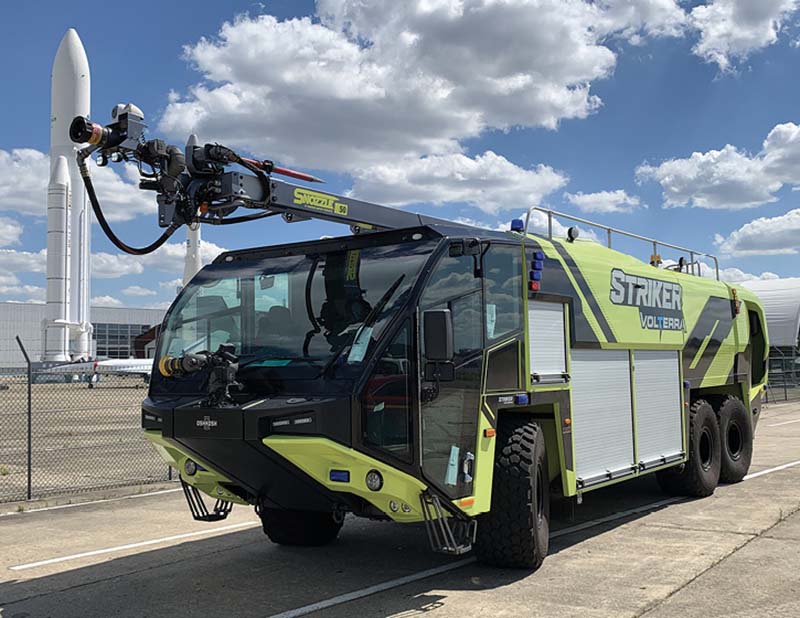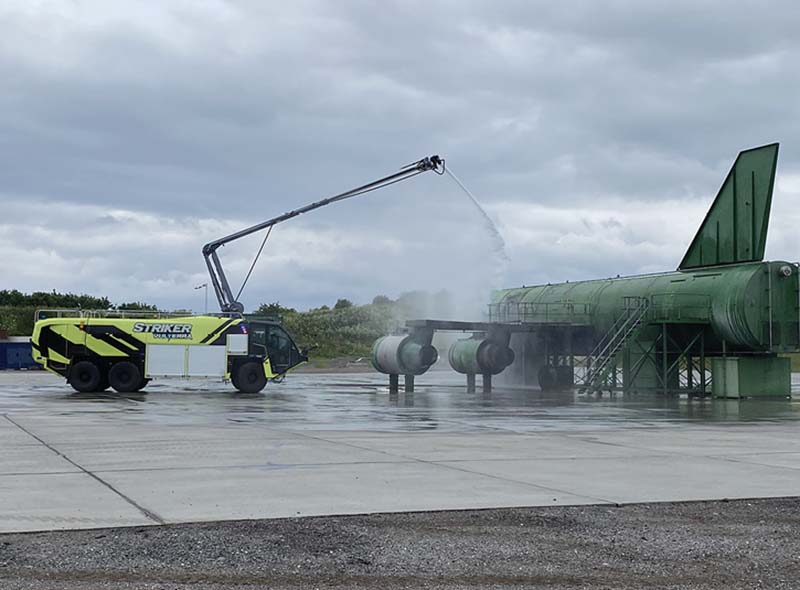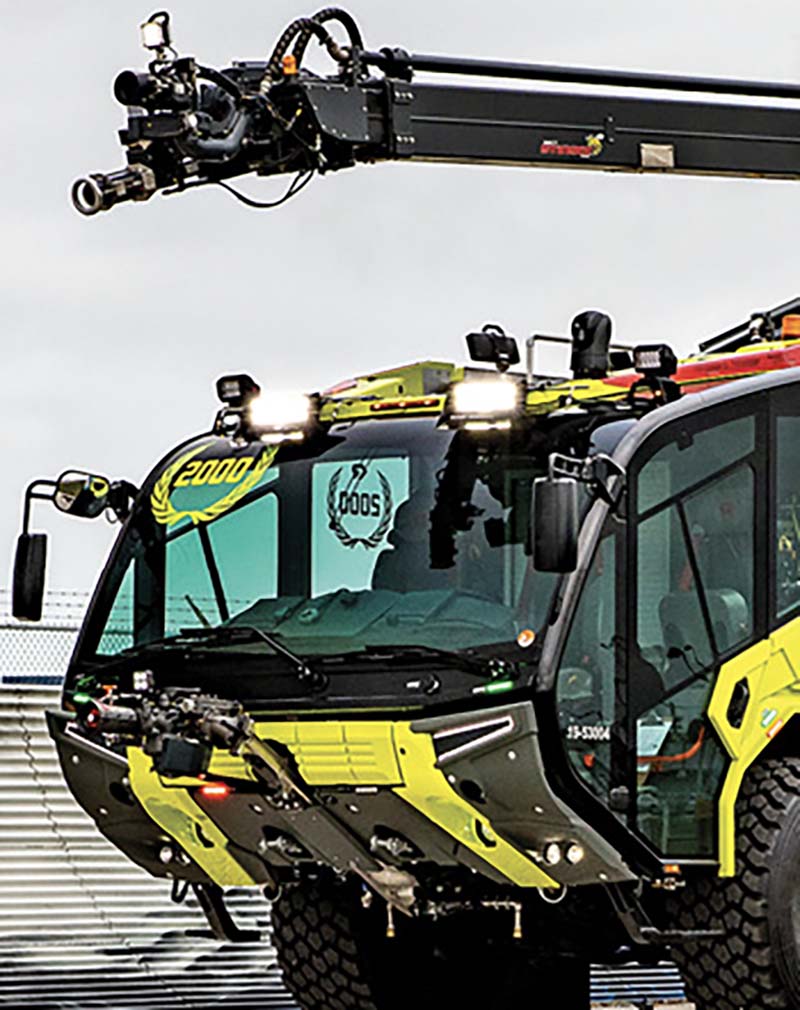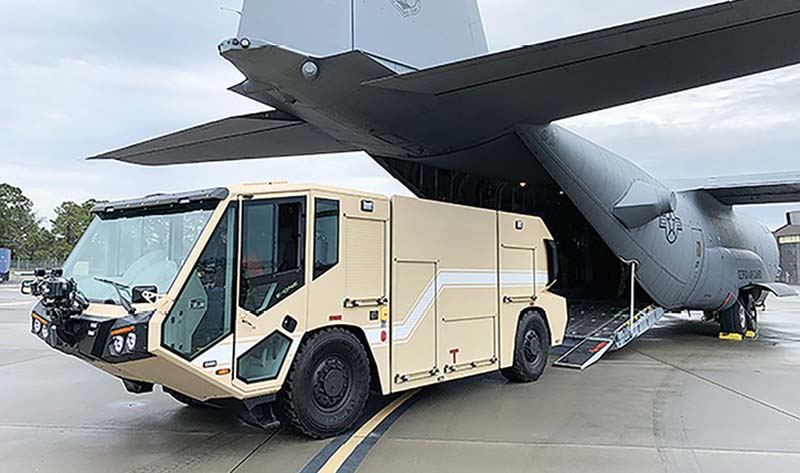Aircraft rescue and firefighting (ARFF) apparatus makers are continually improving their truck designs and the optional equipment that they carry to give ARFF firefighters the best and safest platforms to respond to aircraft incidents.
Jack Bermingham, business unit director of airport products for Oshkosh Airport Products LLC, says Oshkosh is continually looking for new and different ways to meet the challenges firefighters face in airports. “We worked very hard in developing the Striker Volterra™ hybrid electric vehicle (HEV) ARFF truck that we offer on our 4×4 and 6×6 platforms,” Bermingham says. “It has an Oshkosh-patented hybrid electric drivetrain that features an electro-mechanical, infinitely variable transmission that allows zero-emissions operation when powered by the integrated onboard batteries and can be coupled to the internal combustion engine through an Oshkosh power divider to provide continuous and uninterrupted power to the pumping system or the drive system. And, users still enjoy legacy features found on the Striker ARFF vehicle.”
Bermingham points out that autonomy has become a buzzword in ARFF circles. “We’ve added features into our Command Zone™ system on all our ARFF trucks that make the vehicle more autonomous in some configurations,” he says. “For example, if the operator turns on the water pump, the bumper turret automatically turns forward from its stowed position and goes to a straight stream feature of the nozzle, and if the turret has lights, they will automatically come on. This and other autonomous features are configurable by the user.”
Oshkosh also offers the K-Factor™ system on its ARFF vehicles, Bermingham notes. “K-Factor is a visual situational awareness aid that allows the operator to more effectively pierce an aircraft with the high reach extendable turret (HRET) nozzle,” he says. “This piercing alignment tool displays on a screen in the cab and shows the operator how far the piercing tip is from the surface and where it is located on the fuselage.”

1 Oshkosh Airport Products LLC developed the Striker Volterra hybrid electric vehicle ARFF truck in 4×4 and 6×6 (shown) platforms. (Photos 1-2 courtesy of Oshkosh Airport Products LLC.)

2 This Striker Volterra ARFF truck uses its 50-foot Snozzle boom with an HRET during a training exercise.

3 Rosenbauer added a 360° four-camera system to its Panther series of ARFF trucks, giving the operator a choice of a bird’s-eye view, split screen, or individual camera view. (Photos 3-4 courtesy of Rosenbauer.)

4 Rosenbauer Panther ARFF trucks have a bumper turret that can be lowered to apply agent under wings and the fuselage and safe-to-approach lights at the front, rear, and sides to indicate when the vehicle can be safely approached from the outside.
Duane Kann, ARFF regional sales manager for Rosenbauer, says that tweaks and changes made by Rosenbauer focus on safety, maneuverability, and fire suppression capability. “We added safe-to-approach lights to the Panther,” Kann says. “Because an ARFF truck is operated from inside the cab instead of at a pump panel outside, the operator is looking forward and has limited visibility on the sides of the truck through his mirrors. There are now six safe-to-approach lights on the Panther: two in the front, two at the rear, and one above the cab door on each side. When the truck is off, the lights are green, which means it is safe to approach the vehicle.”
Kann notes that Rosenbauer also added a 360° four-camera system that displays on a video screen inside the cab. “The operator has the option of an overview bird’s-eye view of the vehicle, or split screens, or the view from any of the individual cameras,” he says.
Rosenbauer also added a rear steer system to the Panther, Kann says, which gives the truck a tighter turning radius and causes less tire scrub. “It’s an automatic electric-over-hydraulic rear steer system,” he says,” that starts crimping at 10 miles per hour (mph), then backs off incrementally back to zero crimp at 35 mph.” He adds that the Panther also has Rosenbauer’s Roll Stability Control that will take action if the vehicle is cornering too fast by reducing rpm and engaging the brakes to keep the vehicle under control until it is stable again. Kann adds that Rosenbauer developed the system in conjunction with Wabco Engineering.
In another change, Panther’s HVLA RM35 bumper turret has a boom that can be moved vertically down to allow for a low-level attack. “This is especially useful in getting underneath the wings and under the fuselage of an aircraft,” Kann observes. “The operator also is able to put dry chemical agent through the bumper turret, as he also can through the Stinger piercing tip on the HRET on the vehicle’s roof.”

5 E-ONE’s newest ARFF truck is the TITAN 4×4 AT, an air transportable vehicle that can be carried in the fuselage of U.S. Air Force C5, C17, and C130 aircraft. (Photos 5-6 courtesy of E-ONE.)

6 E-ONE also makes the TITAN in 4×4 and 6×6 (shown) models that have a new cabin with more than 7½ square meters of glass area for improved visibility.
Zach Schultz, government sales manager for REV Fire Group, says the most recent design changes to the E-ONE TITAN™ 4×4 and 6×6 models focus on acceleration, braking, dynamic stability, pumping performance, and a new cabin. Schultz notes the new cabin has more than 7½ square meters of glass area with the addition of overhead and large side windows for improved visibility. The cabin interior has seating for four and centrally located vehicle controls for improved efficiency, he adds.
Schultz says, “Both the 4×4 and 6×6 TITAN models are powered by a Scania DC16 Tier 4F/EU Stage 4 engine, 670-horsepower (hp) for the 4×4 and 770-hp for the 6×6, combined with a Twin Disc transmission/transfer case/power divider for superior acceleration, pumping performance, and reliability.”
The TITAN 4×4 AT (Air Transportable) is E-ONE’s newest ARFF truck, Schultz points out, designed for the U.S. Air Force as an ARFF vehicle that can be transported on C5, C17, and C130 aircraft. The vehicle also is being offered for civilian purchase. “On- and off-road capabilities allow the TITAN 4×4 AT to respond in a timely manner to aircraft accident sites across terrain that might otherwise be inaccessible to other standard fire apparatus,” he observes.
Schultz says the TITAN 4×4 AT has a Darley PSP 1,500-gpm single-stage pump, a 1,000-gallon polypropylene water tank, a 140-gallon polypropylene foam tank, disc brakes on the front and rear axles, and an air ride suspension with a kneeling feature.
ALAN M. PETRILLO is a Tucson, Arizona-based journalist, the author of three novels and five nonfiction books, and a member of the Fire Apparatus & Emergency Equipment Editorial Advisory Board. He served 22 years with the Verdoy (NY) Fire Department, including in the position of chief.

